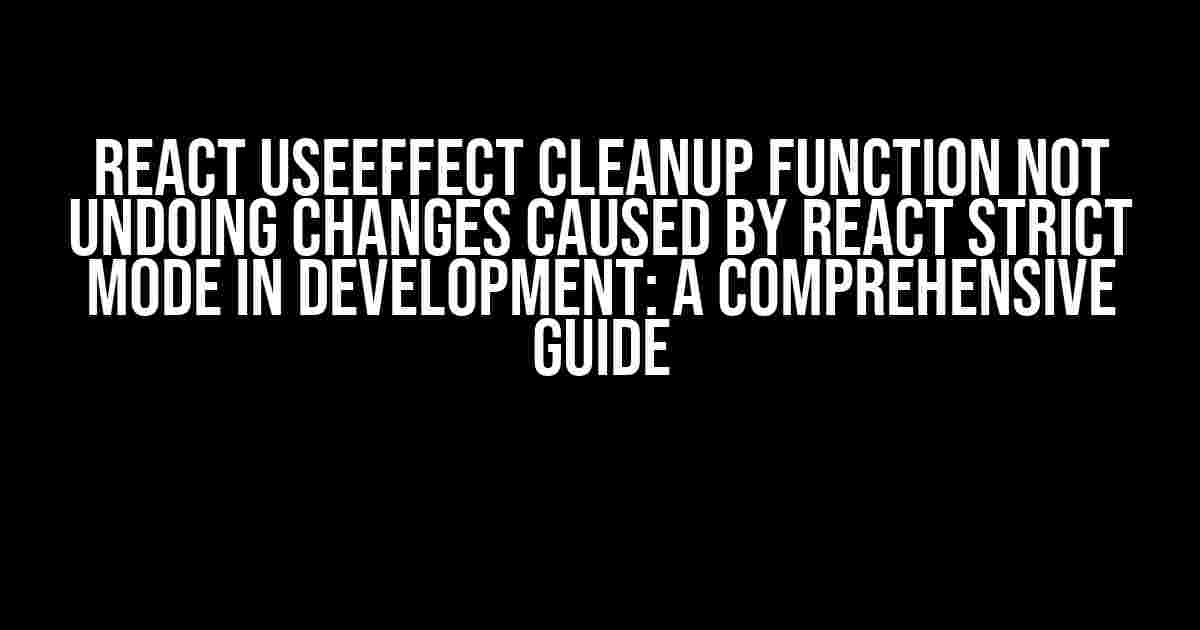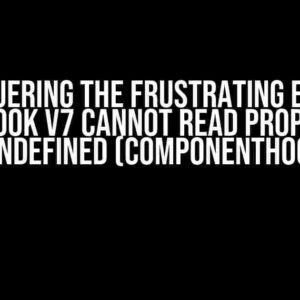Are you tired of scratching your head over why your React useEffect cleanup function is not undoing changes caused by React Strict Mode in development? You’re not alone! In this article, we’ll delve into the world of React Strict Mode, useEffect, and cleanup functions to help you understand what’s going on and how to fix the issue.
What is React Strict Mode?
React Strict Mode is a feature introduced in React 16.3 that helps you catch errors and warnings in your application. When Strict Mode is enabled, React will:
- Check for unexpected side effects in your components
- Warn about legacy context API
- Verify that your components are pure functions
- Help you detect unexpected mutations
In development mode, Strict Mode will re-render your components twice to detect any unexpected side effects. This double rendering can sometimes cause issues with your useEffect cleanup functions, which we’ll explore later.
What is a useEffect Cleanup Function?
The useEffect hook in React is used to handle side effects in functional components. A cleanup function is an optional return value from the useEffect function that gets called when the component is unmounted or re-rendered.
import { useEffect, useState } from 'react';
function MyComponent() {
const [count, setCount] = useState(0);
useEffect(() => {
// Side effect
console.log('Mounted');
// Cleanup function
return () => {
console.log('Unmounted');
};
}, [count]);
return (
Count: {count}
);
}
In this example, the useEffect hook is used to log a message to the console when the component is mounted. The return value from the useEffect function is a cleanup function that gets called when the component is unmounted or re-rendered.
The Problem: useEffect Cleanup Function Not Undoing Changes Caused by React Strict Mode
When you enable React Strict Mode in development, you might notice that your useEffect cleanup functions are not undoing changes caused by the double rendering. This can lead to unexpected behavior and errors in your application.
The reason for this issue is that the useEffect cleanup function is only called when the component is unmounted or re-rendered, but not when the component is re-rendered due to Strict Mode’s double rendering. This means that any changes made by the useEffect function are not undone when the component is re-rendered.
Solution 1: Disable React Strict Mode in Development
One solution is to disable React Strict Mode in development. You can do this by setting the `strictMode` prop to `false` in your `index.js` file:
import React from 'react';
import ReactDOM from 'react-dom';
import App from './App';
ReactDOM.render(
,
document.getElementById('root')
);
However, this solution is not recommended as it defeats the purpose of using React Strict Mode in the first place.
Solution 2: Use a Ref to Store the Cleanup Function
A better solution is to use a ref to store the cleanup function returned by the useEffect hook. This allows you to call the cleanup function manually when the component is re-rendered due to Strict Mode’s double rendering.
import { useEffect, useRef, useState } from 'react';
function MyComponent() {
const [count, setCount] = useState(0);
const cleanupRef = useRef(null);
useEffect(() => {
// Side effect
console.log('Mounted');
// Store the cleanup function in a ref
cleanupRef.current = () => {
console.log('Unmounted');
};
// Return a no-op function to avoid infinite recursion
return () => {};
}, [count]);
// Call the cleanup function manually when the component is re-rendered
if (cleanupRef.current) {
cleanupRef.current();
}
return (
Count: {count}
);
}
In this example, we use a ref to store the cleanup function returned by the useEffect hook. We then call the cleanup function manually when the component is re-rendered due to Strict Mode’s double rendering.
Solution 3: Use a Custom Hook to Handle Cleanup
Another solution is to create a custom hook that handles the cleanup function for you. This can be useful if you have multiple useEffect hooks with cleanup functions in your component.
import { useEffect, useState } from 'react';
const useCleanup = (fn) => {
const cleanupRef = useRef(null);
useEffect(() => {
cleanupRef.current = fn;
}, [fn]);
useEffect(() => {
if (cleanupRef.current) {
cleanupRef.current();
}
});
};
function MyComponent() {
const [count, setCount] = useState(0);
useCleanup(() => {
console.log('Unmounted');
});
useEffect(() => {
console.log('Mounted');
}, [count]);
return (
Count: {count}
);
}
In this example, we create a custom hook called `useCleanup` that takes a function as an argument. The hook stores the function in a ref and calls it when the component is re-rendered.
Conclusion
In this article, we explored the issue of useEffect cleanup functions not undoing changes caused by React Strict Mode in development. We discussed three solutions to this problem: disabling React Strict Mode, using a ref to store the cleanup function, and creating a custom hook to handle cleanup. By understanding how React Strict Mode and useEffect hooks work together, you can write more robust and efficient code that handles side effects and cleanup functions with ease.
| Solution | Description |
|---|---|
| Disable React Strict Mode | Disable Strict Mode in development to avoid the issue, but this defeats the purpose of using Strict Mode. |
| Use a ref to store the cleanup function | Store the cleanup function in a ref and call it manually when the component is re-rendered. |
| Create a custom hook to handle cleanup | Create a custom hook that handles the cleanup function for you, useful for multiple useEffect hooks with cleanup functions. |
We hope this article has helped you understand the issue and find a solution that works for your use case. Happy coding!
Frequently Asked Question
Get answers to the most pressing questions about React useEffect cleanup function not undoing changes caused by React strict mode in development.
Why does React useEffect cleanup function not undo changes caused by React strict mode in development?
React useEffect cleanup function doesn’t undo changes caused by React strict mode in development because, in strict mode, React intentionally re-renders components to detect bugs. Since the cleanup function runs after the component is unmounted, it can’t undo the changes made by the re-render.
How can I prevent the re-rendering of components in React strict mode?
You can prevent re-rendering of components in React strict mode by wrapping your app with a React.StrictMode component and setting the enableComparator prop to false. However, this is not recommended as it may hide potential bugs in your code.
What is the purpose of React strict mode?
React strict mode is a feature that helps you catch bugs and warnings in your code by intentionally re-rendering components and checking for inconsistencies. It’s enabled by default in Create React App and helps ensure that your code is predictable and stable.
How can I handle side effects in React useEffect when strict mode is enabled?
To handle side effects in React useEffect when strict mode is enabled, make sure to clean up after yourself by returning a cleanup function from the effect. This ensures that any side effects are properly cleaned up even when the component is re-rendered.
Are there any alternative solutions to React useEffect for handling side effects?
Yes, there are alternative solutions to React useEffect for handling side effects, such as using React Hooks like useLayoutEffect or useMutationEffect, or using libraries like Redux or React Query to manage global state and side effects.




